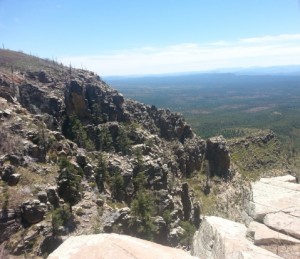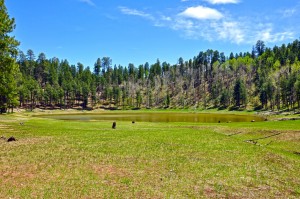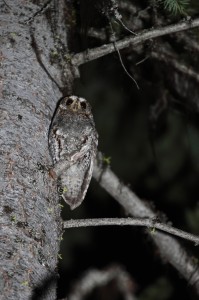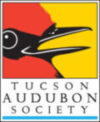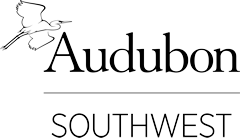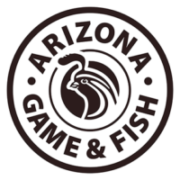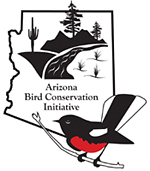Trip report by Craig Anderson for his Arizona IBA Big Year.
The bottom line: the snowmelt draws along the Mogollon Rim are well-worth adding to your high-priority birding locations. Allow yourself two to three days to be in the area.
This is our first trip to the snowmelt draws and it yielded 57 species of birds including two rare or accidental species – an orchard oriole and red-eyed vireo. We also got a high percentage of “expected” birds. Of course, many of these we usually only see if at altitude and in the right habitat – birds such as the red-faced, Grace’s and olive warblers, plumbeous and warbling vireo’s, violet-green and tree swallows and uncommon species such as the goshawk and three-toed woodpecker.
Our first impression of Rim Road 300, about nine miles north of the town Strawberry, is a light brown rutted dirt road winds through the tall dark green trees that seem to touch the sky.
About seven miles onto the road, we arrive at the Kehl Springs Campground. It is a beautiful location adjoining Kehl Springs Canyon, one of the several snowmelt draws we will visit over the next four days. The campground has nine well-placed sites plus a toilet but no other services. We had the campground to ourselves from Monday through Thursday. The Rangers indicated that the campground was usually available most of the summer as most campers go further east to camp at Knoll Lake for fishing. The campground was surrounded by forest and a large half mile-long meadow that was crisscrossed with elk tracks. We were cautioned to use bear-safe camping practices.
Setting up camp was a combination of practicality and birding. We logged eight species including the pine siskin, acorn woodpecker and red-shafted flicker. Later, we would find nearby the nest sites of the white-breasted nuthatch, house wren and common raven. Robins and vireos sang to us while we set up.
“Snowmelt Draws” are narrow drainages that wiggle north (back) from the Rim. They accumulate moisture (snow in the winter) that results from the upward deflection of air at the rim face. Because of the altitude (7,400 feet) and the moisture, these drainages include a rich biodiversity. The habitat includes Ponderosa pine, Douglas fir, southwestern white pine, quaking aspen, Gamble oak, New Mexico locust and maple trees. The drainages were usually stunning meadows 200-300 feet wide covered with clover, grasses, wild flowers and small shrubs. Most of the draws also had small side areas that were often the habitat of particular bird species.
Our first night was spent in camp and the adjacent meadow owling and enjoying the wispy half-moon and the stars twinkling between the trees. Day two found us backtracking West to Potato Lake. The half-mile trail to the lake parallels a velvet green meadow. We started picking up birds immediately and had eleven new species by the time we reached the lake. The list included the dark-eyed juncos unique to the Rim and often referred to as “red-backed.” Pygmy nuthatches, western bluebirds, and western tanagers also added value to this hike.
Potato Lake is a small intimate place, ringed with aspen that I imagine quake and shimmer golden in the fall. The backdrop is a stand of oak and pine trees. Sitting for a spell at the lake, we marveled at the swirling violet-green swallows and added a solo great blue heron who arrived and seemed familiar with the lake.
We returned to the area and nearby Potato Canyon a few days later for a late afternoon hike. After about a quarter mile into the hike, we started seeing frequent and fairly fresh bear scat. We of course had bear spray. Only problem – it was back at the car. We persevered, periodically blowing on our emergency whistles in order to warn bears in the thickets or just around the next curve in the canyon.
My sister and I acutely sensed the presence of bears around us and I periodically felt the hair on my neck bristle. We cautiously continued until we also encountered areas where bears had obviously torn up dead trees in search of grubs and where they had rooted the earth for tubers. In some ways, I was hoping for my first black bear sighting in the wild but all within us was screaming for us to return to the car. Not wanting to come across a bear that had wandered in behind us, we repeated the whistle routine until back at the car just as the sun was beginning to set. Reflecting on this experience, we felt very vulnerable and exhilarated at the same time. This is just one of the ways being in nature makes you feel fully alive!
Over the next two days we explored the draws crossed by FR 141H. This dirt road transects four awesome “Snowmelt Draws” between FR 320A and FR 123, approximately 3.5 miles east of Kehl Springs Campground. We hiked into these breathtaking draws getting most of the trips best birds, including the goshawk and at night the flammulated owl. One could easily spend three or four days just exploring these four draws, and I plan to do so on my next trip. It was while exploring these draws that we saw the most elk often moving like ghosts through the shady forest lining the meadows.
On our final day, we traveled several miles east to Knoll Lake in hopes of getting some waterfowl and to check out the campground. We added common mergansers and a bald eagle, plus scrub jays and a red-tailed hawk on the ride over. The campground had approximately 30-35 sites and some were able to accommodate groups. Toilets and water were also available.
The uniqueness of snowmelt draws makes them a must for my birding locations and I hope this visit to the IBA will generate a visit from you.

